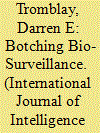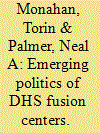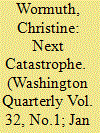| Srl | Item |
| 1 |
ID:
188272


|
|
|
|
|
| Summary/Abstract |
The global COVID-19 pandemic was an intelligence failure, with a death toll orders of magnitude greater than the 11 September 2001 (9/11) attacks on the United States. Multiple factors—of both political and policy natures—contributed to the catastrophe. One area that warrants scrutiny is the United States’ capability for bio-surveillance: identifying the presence of a pathogen before it can take hold within a population. Since 2003, the Department of Homeland Security (DHS) has had a responsibility for one line of defense against biological disasters and yet has stumbled toward implementing that defense, while promising a sense of security that it cannot deliver.
|
|
|
|
|
|
|
|
|
|
|
|
|
|
|
|
| 2 |
ID:
093778


|
|
|
|
|
| Publication |
2009.
|
| Summary/Abstract |
This article explores public concerns about the US Department of Homeland Security's data 'fusion centers'. These centers, which are proliferating across all US states, coordinate data-sharing among state and local police, intelligence agencies, and private companies. The primary goal of fusion centers is to engage in intelligence-sharing for counter-terrorism purposes. However, they have been used for a variety of other purposes, such as basic policing, spying on social movement organizations, or restricting legal public activities such as taking photographs. Drawing upon a comprehensive analysis of media publications from 2002 to 2008, we identify and discuss three primary categories of concern with fusion centers: (1) their ineffectiveness, particularly given the financial expense, the statistical unlikelihood of terrorist attacks, and the pressing need for other law enforcement support; (2) the potential for mission creep, where the functions of fusion centers expand beyond their originally intended purposes to encompass things like all-hazards preparedness; and (3) the violation of civil liberties, especially through racial profiling or First Amendment violations.
|
|
|
|
|
|
|
|
|
|
|
|
|
|
|
|
| 3 |
ID:
086339


|
|
|
|
|
| Publication |
2009.
|
| Summary/Abstract |
The United States is not ready for the next catastrophe. More than seven years have passed since the country was attacked on September 11, 2001 by violent Islamist extremists who remain free, and who have made clear their willingness to use weapons of mass destruction against the United States, should they be able to acquire or build them. Three years have passed since Hurricane Katrina devastated the Gulf Coast and laid bare myriad flaws in the nation's preparedness and response system. Simply creating the Homeland Security Council (HSC), the Department of Homeland Security (DHS), and U.S. Northern Command has not been enough to prepare the country. The United States still lacks detailed, government-wide plans to respond to a catastrophe. There is still considerable confusion over who will be in charge during a disaster. Very few dedicated military forces are on rapid alert to respond to a crisis here at home. And, there are still no guidelines to determine and assess the capabilities that states, cities, and towns should have to ensure they are prepared for the worst.
|
|
|
|
|
|
|
|
|
|
|
|
|
|
|
|
| 4 |
ID:
104250


|
|
|